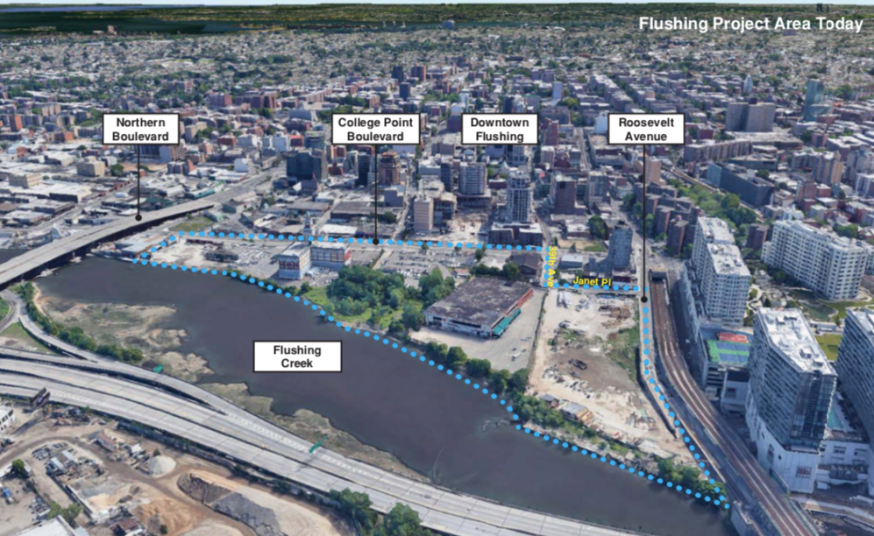
A rendering imagines the proposed Special Flushing Waterfront District, which Community Board 7 is set to vote on at its Monday meeting. (Image Courtesy Hill West Architects)
Feb. 6, 2020 By Ryan Brady
Community Board 7 will vote Monday, Feb. 10, on a major Flushing Creek waterfront special district and rezoning proposal that has generated opposition from area residents.
The land-use application from a landowner consortium called FWRA LLC seeks to turn 29 acres of mostly inactive property into the Special Flushing Waterfront District. There, a 13-tower, three million square foot mixed-use development would rise.
The space is bound by the creek to the west, 36th Avenue to the north, College Point Boulevard to the east and Roosevelt Avenue to the south. Under the plan, brownfield remediation would take place before construction starts.
Nearly 70 percent of the building area would be occupied by 1,725 residential units and 879 hotel rooms, with the rest of it being office and retail space. The development would also feature a publicly accessible waterfront park, around 1,600 parking spaces and a privately-owned road network open to outside traffic.
Much of the plan is as-of-right. But the application does request a rezoning for a small, northern chunk of the site where 300 of the residential units would be built. The space in question would go from an M3-1 manufacturing zone to one for M1-2/R7-1, a designation that allows residential usage. Because housing could be built as-of-right on the rest of the land, the city’s Mandatory Inclusionary Housing policy only requires the construction of 75 to 90 affordable units for the entire project.
In a statement, FWRA said the proposal “creates an integrated development strategy that knits together this area with Downtown Flushing and the Flushing Creek waterfront to become a beacon for Flushing and Queens.”
The developers have said that if the application isn’t approved, they will build a project that lacks the affordable units and road network of the existing proposal and features less public space by the creek.
CB 7’s decision is only advisory. After the board’s vote, the proposal moves to the borough president, the City Planning Commission and the City Council. When it comes to rezonings, Council custom dictates that it make a decision based on the stance of its member representing the area in question — in this case, Peter Koo.
The Flushing lawmaker is still evaluating the plan.
“The proposed Special Waterfront District could significantly transform the isolated waterfront of downtown Flushing,” Koo spokesman Scott Sieber said in a statement. “That said, we have many outstanding questions, so we’re watching very closely, but whatever is ultimately built here needs to enhance the downtown Flushing community as much as possible.”

A largely inactive part of Flushing’s waterfront would be radically transformed by the Special Flushing Waterfront District proposal that Community Board 7 will vote on at its Monday meeting. (Image Courtesy Hill West Architects)
Last month, CB 7’s Land Use Committee approved the project in a 15-1 vote. Joe Sweeney, the committee chairman, is especially pleased with FWRA’s road network plan.
“That is a big win because that will help with the traffic on College Point Boulevard,” he said.
However, the committee did create a list of recommendations to city officials and FWRA aimed at resolving issues that the development could create. Among other measures, it calls for a new public school in the area, where classroom overcrowding is highly common. Sweeney’s committee also wants Flushing’s No. 7 train station expanded west to Prince Street, closer to the proposed district.
Residents against the project charge it would worsen displacement and gentrification in Flushing. The critics have protested the proposal at recent CB 7 meetings.
Two of the main groups resisting the rezoning, the MinKwon Center for Community Action and Chhaya CDC, are urging stakeholders to voice their concerns at the Feb. 10 meeting.
Assemblymember Ron Kim is on the opponents’ side. He says the project would make it harder for non-wealthy families to live in Flushing. Though the lawmaker has no formal power to stop the plan, he’s urging those who do to pay attention to critics’ concerns.
“Folks can’t keep up with the pace of all the market-driven rent increases that are pricing out a lot of low-income and middle-class families,” he said.
CB 7 First Vice Chairman Chuck Apelian has recused himself from voting on the application because he is a hired consultant for FWRA. He could not be reached for comment prior to deadline.
The board’s Monday meeting will happen at 7 p.m. on the ninth floor of 33-23 Union St.
One Comment

Coronavirus !!